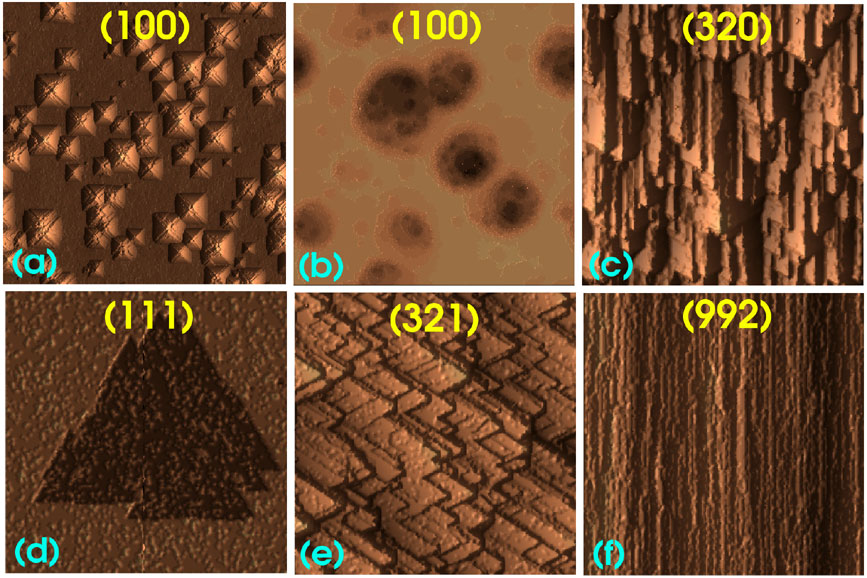Abstract.
The rich variety of micron-scale features observed in the orientation dependent surface morphology of crystalline silicon during anisotropic wet chemical etching is shown to have its origin at the atomistic scale. Realistic Monte Carlo simulations show that the pyramidal hillocks on Si(100) are the result of local stabilization of distributed apex atoms by (metal) impurities from solution. In the absence of this stabilization, shallow round pits are formed on Si(100) as a result ofthe anisotropy between (onelayer deep) pit nucleation and (isotropic) step propagation. It is also concluded that nosed zigzag structures at vicinal (110) are the combined result of misaligment and the etching anisotropy, showing that the nucleating mechanisms of morphologically related structures such as pyramidal hillocks and nosed zigzags are not necessarily the same. The simulations confifirm that the formation of (one layer deep) triangular and hexagonal pits on exact Si(111) and of polygonal (saw-shaped) and straight terraces in vicinal Si(111) depends on the relative rate of and step propagation and on the misorientation of the surface with respect to Si(111).
Anisotropic wet chemical etching remains the most widely used processing technique in silicon technology. Used in combination with a multitude of other processes, it has a wide range of applications in microelectromechanical systems (MEMS), including pressure [1, 2], acceleration [3], angular rate [2] and gas-flflow sensors [2, 4], actuators [5], nanoprobes [6, 7], nanowires [7], micromirrors [8], laser cavities [9], optical switches [10, 11], aligment grooves [12] and microvalves [13], to mention only a few. Its wide presence is not only due to its ease of use and low cost, but also due to the fact that it provides fairly smooth surfaces with no physical damage to the bulk. However, in the past few years, the roughness of the etched surface has begun to play an increasingly important role as the size of the devices is continuously reduced. The performance of a growing number of micromechanical devices requires very smooth surfaces and the precise production conditions need to be found. It has become apparent that there is a need to improve the understanding of the process in general and, in particular, of the mechanisms that lead to the characteristic morphological features of the etched surfaces.
During recent years, much effort has been dedicated to the characterization and understanding of the surface morphology during wet chemical etching, both experimentally , and theoretically , . Specifific studies of the most frequent surface inhomogeneities,such as pyramidal hillocks , (fifigure 1(a)) and shallow round pits (fifigure 1(b)) on Si(100), nosed zigzag structures (fifigure 1(c)) on (vicinal) Si(110) and triangular pits, (fifigure 1(d)) on Si(111), have provided important insights into the problem. As an example, there exists extended consensus that the atomistic nucleation of pits on Si(111) is enhanced by the existence of linear dislocations [26] accumulated in the surface region during thermal oxidation [27] and that the development of a triangular or hexagonal pit geometry depends on the relative values of the microscopic reaction rates of the atoms sitting at the and step families Recently, a mechanism explaining the dependence of these shapes on concentration/coverage has been suggested [30]. Similarly, there is also agreement that the pyramidal hillocks on Si(100) are necessarily nucleated by a stabilizing mechanism, although the nature of the mechanism itself is still in debate.
Systematic studies of the dependence of the surface morphology on orientation [14]–[16] have provided a more general perspective on the problem, establishing morphological relations between some of the surface features such as the pyramidal hillocks on Si(100) and the nosed zigzags on Si(110) or the formation of polygonal-stepped (figure 1(e)) and straight terraces (fifigure 1(f)) in vicinal Si(111). Also, from a more general perspective, the specifific features of the surface morphology in anisotropic wet chemical etching of silicon are only an example of a wider range of morphological features observed in other etched or grown materials. An improved understanding of the mechanisms generating these features in wet chemical etching may help in other disciplines.

The purpose of the present work is to stress the fact that most of the morphologic features in wet chemical etching are directly the result of atomistic processes. This is an important observation that has been traditionally overlooked, especially in the case of the formation of pyramidal hillocks, whose origin has been related to larger objects such as re-deposited islands, silica particles or hydrogen bubbles, as discussed in section 3.5. We will show that a realistic model based on simple atomistic considerations can generate simultaneously (with the same parameters) pyramidal hillocks on Si(100), nosed zigzags on (vicinal) Si(110), polygonal and flflat terraces on vicinal Si(111) and triangular pits on exact (111). In doing this, we will learn about the specifific amplifification mechanisms that provide the link between the atomistic processes and the macroscopic morphologic features. In the particular case of the pyramidal hillocks and round pits on Si(100), the temperature and concentration/coverage dependence will be examined. Based on the fact that pyramidal hillocks and shallow round pits on Si(100) are observed under different experimental conditions, we will use two sets of parameters. Interestingly, it will be shown that the general features of the surface morphology at the other orientations do not depend critically on the choice between these two.
上一篇: 氮化栅氧化物的表面制备挑战
下一篇: 晶圆背面清洁工艺